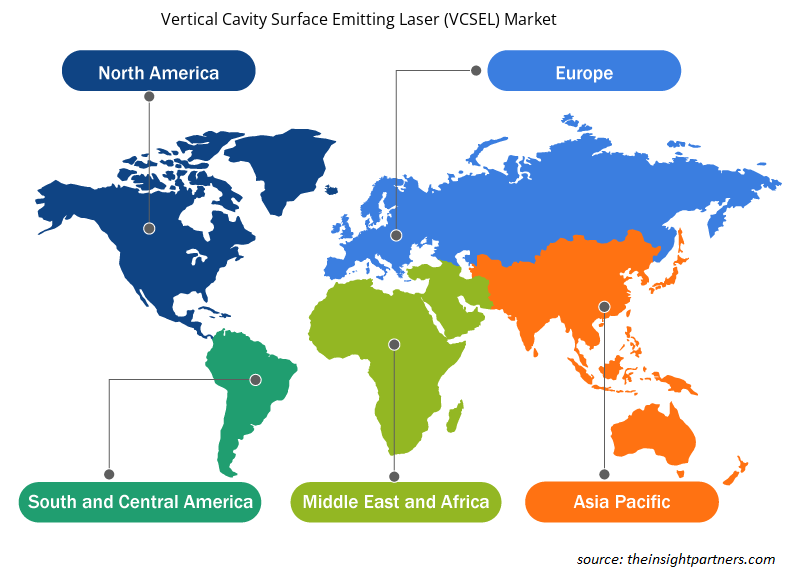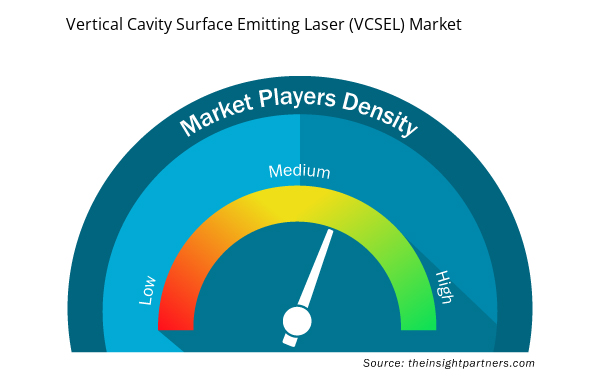垂直腔面发射激光器 (VCSEL) 市场规模预计将从 2022 年的 13.61 亿美元增至 2030 年的 46.63 亿美元。预计 2023-2030 年期间市场复合年增长率将达到 17.0%。电子产品小型化可能仍是市场的主要趋势。
垂直腔面发射激光器 (VCSEL) 市场分析
互联网普及率和物联网设备的增加以及新兴电信行业正在推动市场发展。由于 VCSEL 在 3D 传感应用中的采用率不断提高,预计市场在预测期内将大幅扩张。此外,医疗设备行业的扩张和数据中心数量的增加为市场创造了丰厚的机会。
垂直腔面发射激光器 (VCSEL) 市场概览
垂直腔面发射激光器 (VCSEL) 是一种半导体激光二极管,它产生垂直于表面的激光束,而边缘发射激光二极管则从晶圆上切下单个芯片产生的表面发出激光束。因此,VCSEL 的性能优于边缘发射激光二极管。边缘发射激光器在沉积过程完成之前无法评估;如果后来发现缺陷,修复可能既耗时又昂贵。信号处理是 VCSEL 设备在传感和通信应用中的一项关键功能,这推动了传感应用中对 VCSEL 的需求。
定制此报告以满足您的需求
您可以免费定制任何报告,包括本报告的部分内容、国家级分析、Excel 数据包,以及为初创企业和大学提供优惠和折扣
- 获取此报告的关键市场趋势。这个免费样品将包括数据分析,从市场趋势到估计和预测。
垂直腔面发射激光器 (VCSEL) 市场驱动因素和机遇
互联网普及率上升及物联网设备利好市场
由于互联网普及率和物联网设备的增加,对高速数据通信的需求正在增加。高效的网络和数据通信可在世界任何两点之间提供无缝的数据交换。VCSEL 是数据通信和传感的理想光源。由于功耗较低,它是光子集成电路的有前途的来源,有助于其在数据通信网络中的应用。为了满足不断增长的需求,市场参与者正在推出新产品。2023 年 2 月,总部位于美国的 Coherent Corp. 推出了用于 800G 短距离数据通信可插拔收发器和有源光缆 (AOC) 的 100G PAM4 VCSEL 和光电二极管 (PD) 阵列。这些功率较低的 VCSEL 和 PD 可降低每比特的能耗,从而提供高效的数据通信。此外,Lumentum Operations LLC、Coherent Corp、Broadcom 和 RPMC Lasers 等多家 VCSEL 市场参与者的存在可能会促进 VCSEL 市场的增长。
不断扩大的医疗器械行业
根据国际贸易管理局 2022 年 8 月的数据,加拿大的医疗器械行业高度多样化,拥有多家大型、小型和中型企业 (SME)。其中包括 INNOVA Medical、Clarius、Starkey 和 BIOS Medical。由于医疗器械制造商的广泛存在,加拿大的医疗器械市场在 2021 年的价值约为 65 亿美元,预计到 2026 年每年将增长 2.1%。VCSEL 提供更广泛可用波长范围的特性提高了医疗器械的性能和可靠性。因此,不断增长的医疗器械市场刺激了对 VCSEL 的需求,推动其在预测期内的增长。
垂直腔面发射激光器 (VCSEL) 市场报告细分分析VCSEL) Market Report Segmentation Analysis
有助于得出垂直腔面发射激光器 (VCSEL) 市场VCSEL) market分析的关键部分是类型、材料、数据速率、波长、应用和最终用途行业。
- 根据类型,垂直腔面发射激光器 (VCSEL) 市场分为单模和多模。单模部分在 2023 年占据了较大的市场份额。
- 根据材料,市场分为砷化镓 (GaAs)、磷化铟 (InP) 和其他材料。砷化镓 (GaAs) 部分在 2023 年占据了较大的市场份额。
- 就数据速率而言,市场分为高达 10 GBPS、10.1 至 25 GBPS 和 25 GBPS 以上。2023 年,25 GBPS 以上的部分将占据更大的市场份额。
- 根据波长,垂直腔面发射激光器 (VCSEL) 市场细分为红色、近红外 (NIR) 和短波红外 (SWIR)。近红外 (NIR) 部分在 2023 年占据了更大的市场份额。
- 根据应用,市场细分为传感、数据通信、工业加热和打印等。传感领域在 2023 年占据了更大的市场份额。
- 根据终端使用行业,市场分为移动和消费、电信和基础设施、工业、国防和航空航天、医疗以及汽车和移动。移动和消费领域在 2023 年占据了更大的市场份额。
垂直腔面发射激光器 (VCSEL) 市场份额(按地区)分析
垂直腔面发射激光器(VCSEL)市场报告的地理范围主要分为五个区域:北美、亚太、欧洲、中东和非洲、南美和中美。
由于各行业对半导体的需求不断增长,预计亚太地区市场将在预测期内扩大。由于政府出台了多项举措,如“中国制造 2025”,以促进全国的本土制造业,中国已成为半导体行业的领先参与者之一。中国的半导体行业由多家公司组成,这些公司为汽车、消费电子、电信和航空航天等多个行业对半导体的需求不断增长做出了贡献。该国的一些主要电子制造商包括比亚迪电子和华为技术有限公司。因此,电子公司投资从中国采购技术以促进本地生产,从而促进市场增长。
垂直腔面发射激光器 (VCSEL) 市场区域洞察
Insight Partners 的分析师已详尽解释了预测期内影响垂直腔面发射激光器 (VCSEL) 市场的区域趋势和因素。本节还讨论了北美、欧洲、亚太地区、中东和非洲以及南美和中美洲的垂直腔面发射激光器 (VCSEL) 市场细分和地理位置。

- 获取垂直腔面发射激光器 (VCSEL) 市场的区域特定数据
垂直腔面发射激光器 (VCSEL) 市场报告范围
| 报告属性 | 细节 |
|---|---|
| 2023 年的市场规模 | 15.6亿美元 |
| 2031 年市场规模 | 55.3亿美元 |
| 全球复合年增长率(2023 - 2031) | 17.1% |
| 史料 | 2021-2022 |
| 预测期 | 2024-2031 |
| 涵盖的领域 | 按类型
|
| 覆盖地区和国家 | 北美
|
| 市场领导者和主要公司简介 |
|
垂直腔面发射激光器 (VCSEL) 市场参与者密度:了解其对业务动态的影响
垂直腔面发射激光器 (VCSEL) 市场正在快速增长,这得益于终端用户需求的不断增长,而这些需求又源于消费者偏好的不断变化、技术进步以及对产品优势的认识不断提高等因素。随着需求的增加,企业正在扩大其产品范围,进行创新以满足消费者的需求,并利用新兴趋势,从而进一步推动市场增长。
市场参与者密度是指在特定市场或行业内运营的企业或公司的分布情况。它表明在给定市场空间中,相对于其规模或总市场价值,有多少竞争对手(市场参与者)存在。
垂直腔面发射激光器 (VCSEL) 市场的主要公司有:
- Lumentum 控股公司
- 相干公司
- 通快集团
- 博通公司
- 艾迈斯半导体
- 维拓莱特股份有限公司
免责声明:上面列出的公司没有按照任何特定顺序排列。

- 获取垂直腔面发射激光器 (VCSEL) 市场顶级关键参与者概览
垂直腔面发射激光器 (VCSEL) 市场新闻和最新发展
垂直腔面发射激光器 (VCSEL) 市场通过收集一手和二手研究后的定性和定量数据进行评估,其中包括重要的公司出版物、协会数据和数据库。下面列出了垂直腔面发射激光器 (VCSEL) 市场的一些发展情况:
- TRUMPF 在工业级制造水平上展示了 1300 nm 以上长波长红外激光元件效率方面的出色成果。这使 TRUMPF 朝着 1300 nm 至 2000 nm 范围内磷化铟 (InP) VCSEL 的量产又迈进了一步。(来源:TRUMPF SE + Co KG,公司网站,2023 年 1 月)。
- 所推出的产品 M30 参考设计将 Lumentum 的 M52-100 多结垂直腔面发射激光器 (VCSEL) 阵列与 Lumotive 的 LCM 光束控制芯片相结合。(来源:Lumentum Holdings Inc,公司网站,2023 年 1 月)。
垂直腔面发射激光器 (VCSEL) 市场报告覆盖范围和交付成果
“垂直腔面发射激光器 (VCSEL) 市场规模和预测 (2021-2031)”报告对以下领域进行了详细的市场分析:
- 垂直腔面发射激光器 (VCSEL) 市场规模及预测,涵盖全球、地区和国家层面的所有关键细分市场
- 垂直腔面发射激光器 (VCSEL) 市场趋势以及市场动态,如驱动因素、限制因素和关键机遇
- 详细的 PEST/波特五力分析和 SWOT 分析
- 垂直腔面发射激光器 (VCSEL) 市场分析涵盖主要市场趋势、全球和区域框架、主要参与者、法规和最新市场发展
- 行业格局和竞争分析,涵盖市场集中度、热图分析、知名参与者以及垂直腔面发射激光器 (VCSEL) 市场的最新发展
- 详细的公司简介
- 历史分析(2 年)、基准年、预测(7 年)及复合年增长率
- PEST 和 SWOT 分析
- 市场规模价值/数量 - 全球、区域、国家
- 行业和竞争格局
- Excel 数据集


- Molecular Diagnostics Market
- Green Hydrogen Market
- Investor ESG Software Market
- Virtual Production Market
- Advanced Planning and Scheduling Software Market
- Sweet Potato Market
- Batter and Breader Premixes Market
- Electronic Data Interchange Market
- Employment Screening Services Market
- Pressure Vessel Composite Materials Market

Report Coverage
Revenue forecast, Company Analysis, Industry landscape, Growth factors, and Trends

Segment Covered
This text is related
to segments covered.

Regional Scope
North America, Europe, Asia Pacific, Middle East & Africa, South & Central America

Country Scope
This text is related
to country scope.
常见问题
The global vertical cavity surface emitting laser (VCSEL) market is expected to reach US$ 5.53 billion by 2031.
The global vertical cavity surface emitting laser (VCSEL) market is estimated to register a CAGR of 17.1% during the forecast period 2023–2031.
North America dominated the vertical cavity surface emitting laser (VCSEL) market in 2023.
The key players holding majority shares in the global vertical cavity surface emitting laser (VCSEL) market are Lumentum Holdings Inc, Coherent Corp, TRUMPF SE + Co KG, Broadcom Inc, ams-OSRAM AG, Vertilite Co Ltd, Leonardo SpA, IQE Plc, VERTILAS GmbH, and Hamamatsu Photonics KK.
Miniaturization in electronics to play a significant role in the global vertical cavity surface emitting laser (VCSEL) market in the coming years.
Rise in internet penetration and loT devices and emerging telecommunication industry are the major factors that propel the global vertical cavity surface emitting laser (VCSEL) market.
Trends and growth analysis reports related to Electronics and Semiconductor : READ MORE..
The List of Compnies - Vertical Cavity Surface Emitting Laser (VCSEL) Market
- Lumentum Holdings Inc
- Coherent Corp
- TRUMPF SE + Co KG
- Broadcom Inc
- ams-OSRAM AG
- Vertilite Co Ltd
- Leonardo SpA
- IQE Plc
- VERTILAS GmbH
- Hamamatsu Photonics KK
The Insight Partners performs research in 4 major stages: Data Collection & Secondary Research, Primary Research, Data Analysis and Data Triangulation & Final Review.
- Data Collection and Secondary Research:
As a market research and consulting firm operating from a decade, we have published and advised several client across the globe. First step for any study will start with an assessment of currently available data and insights from existing reports. Further, historical and current market information is collected from Investor Presentations, Annual Reports, SEC Filings, etc., and other information related to company’s performance and market positioning are gathered from Paid Databases (Factiva, Hoovers, and Reuters) and various other publications available in public domain.
Several associations trade associates, technical forums, institutes, societies and organization are accessed to gain technical as well as market related insights through their publications such as research papers, blogs and press releases related to the studies are referred to get cues about the market. Further, white papers, journals, magazines, and other news articles published in last 3 years are scrutinized and analyzed to understand the current market trends.
- Primary Research:
The primarily interview analysis comprise of data obtained from industry participants interview and answers to survey questions gathered by in-house primary team.
For primary research, interviews are conducted with industry experts/CEOs/Marketing Managers/VPs/Subject Matter Experts from both demand and supply side to get a 360-degree view of the market. The primary team conducts several interviews based on the complexity of the markets to understand the various market trends and dynamics which makes research more credible and precise.
A typical research interview fulfils the following functions:
- Provides first-hand information on the market size, market trends, growth trends, competitive landscape, and outlook
- Validates and strengthens in-house secondary research findings
- Develops the analysis team’s expertise and market understanding
Primary research involves email interactions and telephone interviews for each market, category, segment, and sub-segment across geographies. The participants who typically take part in such a process include, but are not limited to:
- Industry participants: VPs, business development managers, market intelligence managers and national sales managers
- Outside experts: Valuation experts, research analysts and key opinion leaders specializing in the electronics and semiconductor industry.
Below is the breakup of our primary respondents by company, designation, and region:

Once we receive the confirmation from primary research sources or primary respondents, we finalize the base year market estimation and forecast the data as per the macroeconomic and microeconomic factors assessed during data collection.
- Data Analysis:
Once data is validated through both secondary as well as primary respondents, we finalize the market estimations by hypothesis formulation and factor analysis at regional and country level.
- Macro-Economic Factor Analysis:
We analyse macroeconomic indicators such the gross domestic product (GDP), increase in the demand for goods and services across industries, technological advancement, regional economic growth, governmental policies, the influence of COVID-19, PEST analysis, and other aspects. This analysis aids in setting benchmarks for various nations/regions and approximating market splits. Additionally, the general trend of the aforementioned components aid in determining the market's development possibilities.
- Country Level Data:
Various factors that are especially aligned to the country are taken into account to determine the market size for a certain area and country, including the presence of vendors, such as headquarters and offices, the country's GDP, demand patterns, and industry growth. To comprehend the market dynamics for the nation, a number of growth variables, inhibitors, application areas, and current market trends are researched. The aforementioned elements aid in determining the country's overall market's growth potential.
- Company Profile:
The “Table of Contents” is formulated by listing and analyzing more than 25 - 30 companies operating in the market ecosystem across geographies. However, we profile only 10 companies as a standard practice in our syndicate reports. These 10 companies comprise leading, emerging, and regional players. Nonetheless, our analysis is not restricted to the 10 listed companies, we also analyze other companies present in the market to develop a holistic view and understand the prevailing trends. The “Company Profiles” section in the report covers key facts, business description, products & services, financial information, SWOT analysis, and key developments. The financial information presented is extracted from the annual reports and official documents of the publicly listed companies. Upon collecting the information for the sections of respective companies, we verify them via various primary sources and then compile the data in respective company profiles. The company level information helps us in deriving the base number as well as in forecasting the market size.
- Developing Base Number:
Aggregation of sales statistics (2020-2022) and macro-economic factor, and other secondary and primary research insights are utilized to arrive at base number and related market shares for 2022. The data gaps are identified in this step and relevant market data is analyzed, collected from paid primary interviews or databases. On finalizing the base year market size, forecasts are developed on the basis of macro-economic, industry and market growth factors and company level analysis.
- Data Triangulation and Final Review:
The market findings and base year market size calculations are validated from supply as well as demand side. Demand side validations are based on macro-economic factor analysis and benchmarks for respective regions and countries. In case of supply side validations, revenues of major companies are estimated (in case not available) based on industry benchmark, approximate number of employees, product portfolio, and primary interviews revenues are gathered. Further revenue from target product/service segment is assessed to avoid overshooting of market statistics. In case of heavy deviations between supply and demand side values, all thes steps are repeated to achieve synchronization.
We follow an iterative model, wherein we share our research findings with Subject Matter Experts (SME’s) and Key Opinion Leaders (KOLs) until consensus view of the market is not formulated – this model negates any drastic deviation in the opinions of experts. Only validated and universally acceptable research findings are quoted in our reports.
We have important check points that we use to validate our research findings – which we call – data triangulation, where we validate the information, we generate from secondary sources with primary interviews and then we re-validate with our internal data bases and Subject matter experts. This comprehensive model enables us to deliver high quality, reliable data in shortest possible time.


 获取此报告的免费样本
获取此报告的免费样本